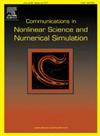A class of time-changed Mckean–Vlasov stochastic differential equations with super-linear drift and Hölder diffusion coefficients
IF 3.8
2区 数学
Q1 MATHEMATICS, APPLIED
Communications in Nonlinear Science and Numerical Simulation
Pub Date : 2025-09-18
DOI:10.1016/j.cnsns.2025.109304
引用次数: 0
Abstract
This paper investigates a class of time-changed McKean-Vlasov stochastic differential equations (MV-SDEs) characterized by super-linear drift and Hölder-continuous diffusion coefficients. The system features two distinct drift components: one driven by the random time change and the other driven by a regular, non-random time variable . Through the construction of interacting particle systems, we establish the existence and uniqueness of strong solutions by developing an Euler-type interpolation scheme combined with refined Yamada-Watanabe techniques and strategic sample space partitioning. Furthermore, the strong convergence in the finite time of the tamed Euler Maruyama (EM) method on the particle system is discussed. Finally, the theoretical framework is substantiated through two representative examples demonstrating the efficacy of our methodology.
一类具有超线性漂移和Hölder扩散系数的时变Mckean-Vlasov随机微分方程
研究了一类具有超线性漂移和Hölder-continuous扩散系数的时变McKean-Vlasov随机微分方程(MV-SDEs)。该系统具有两个不同的漂移分量:一个由随机时间变化Et驱动,另一个由规则的非随机时间变量t驱动。通过构建相互作用粒子系统,我们开发了一种欧拉型插值方案,结合改进的Yamada-Watanabe技术和策略样本空间划分,建立了强解的存在性和唯一性。进一步讨论了正则欧拉Maruyama (EM)方法在有限时间内对粒子系统的强收敛性。最后,通过两个有代表性的例子证明了我们的方法的有效性,从而证实了理论框架。
本文章由计算机程序翻译,如有差异,请以英文原文为准。
求助全文
约1分钟内获得全文
求助全文
来源期刊

Communications in Nonlinear Science and Numerical Simulation
MATHEMATICS, APPLIED-MATHEMATICS, INTERDISCIPLINARY APPLICATIONS
CiteScore
6.80
自引率
7.70%
发文量
378
审稿时长
78 days
期刊介绍:
The journal publishes original research findings on experimental observation, mathematical modeling, theoretical analysis and numerical simulation, for more accurate description, better prediction or novel application, of nonlinear phenomena in science and engineering. It offers a venue for researchers to make rapid exchange of ideas and techniques in nonlinear science and complexity.
The submission of manuscripts with cross-disciplinary approaches in nonlinear science and complexity is particularly encouraged.
Topics of interest:
Nonlinear differential or delay equations, Lie group analysis and asymptotic methods, Discontinuous systems, Fractals, Fractional calculus and dynamics, Nonlinear effects in quantum mechanics, Nonlinear stochastic processes, Experimental nonlinear science, Time-series and signal analysis, Computational methods and simulations in nonlinear science and engineering, Control of dynamical systems, Synchronization, Lyapunov analysis, High-dimensional chaos and turbulence, Chaos in Hamiltonian systems, Integrable systems and solitons, Collective behavior in many-body systems, Biological physics and networks, Nonlinear mechanical systems, Complex systems and complexity.
No length limitation for contributions is set, but only concisely written manuscripts are published. Brief papers are published on the basis of Rapid Communications. Discussions of previously published papers are welcome.
 求助内容:
求助内容: 应助结果提醒方式:
应助结果提醒方式:


